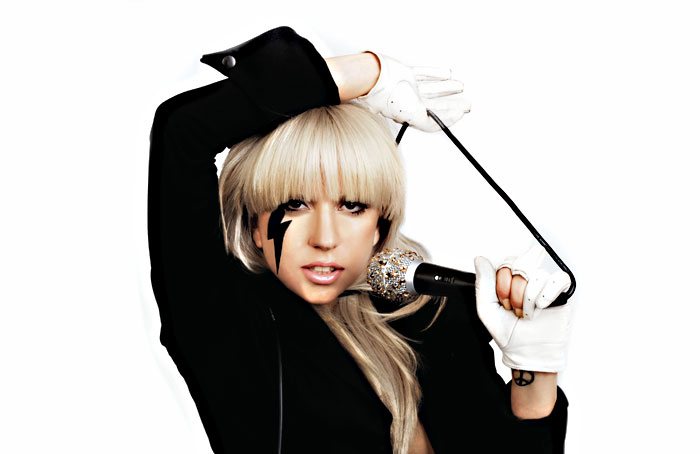Barely anyone paid attention to my music writing until I began reviewing concerts by pop acts like the Backstreet Boys and Celine Dion. Suddenly I was on KIRO with Luke Burbank discussing if it felt like I was “swimming upstream” covering mainstream popular culture for an alternative weekly. I actually hadn’t considered it until then, but he raised a good point. Seattle—like many cities—is scared shitless of pop music. Its fans went into hiding long ago after constant abuse from musicians and music snobs alike.
But there’s hope for the brave and unabashed pop worshippers still out there. Earlier this year a relatively unknown artist named Lady GaGa (Stefani Germanotta) stormed into Neighbours unannounced, infiltrating the club with a set that sounded like a mashup of Billy Idol, Madonna, and Peaches spun by a drunk DJ. She wore a platinum blonde wig and a red American Apparel outfit so tight it could trigger a yeast infection. She looked like Ziggy Stardust in hooker heels and electrified the crowd. “Pop music will never be lowbrow—at least not on my stage,” GaGa concluded with a smirk.
The New York–bred artist has made that sentiment her mantra in a music career that’s certain to rise to mainstream popularity now that she’s released her debut album The Fame and is touring the nation with New Kids on the Block. She’s even (wisely) befriended celebrity blogger Perez Hilton, whose effusive Web postings have helped catapult her success on the Internet. But GaGa is aware she still has her work cut out for her, given our aversion to pop music. And she’s up for the challenge.
“I have a fascination with Andy Warhol and the way he wanted to make commercial art that was taken as seriously as fine art,” GaGa says. “Music has gotten so pretentious that now it’s almost rebellious to be a pop artist. A lot of indie-rock bands and singer-songwriters have this middle finger up at the pop world and record labels.
“There’s been a lot of damage done over the past 30 years with artists saying that pop music sucks. It’s lowbrow, manufactured, fake, plastic…They say we need to go back to the ‘real music,’ so we’ve had to listen to some really depressing singer-songwriters and indie-rock bands.”
Gaga’s musical journey began more glamorous than torturous. She never lived in a van or got her heart trampled on. Prior to relocating to Los Angeles to record a solo record, she was a popular fixture for several years in New York’s club scene. She and Lower East Side DJ Lady Starlight hosted a weekly party called “New York Street Revival and Trash Dance” in which they performed ’70s and ’80s hits. Their outrageous performances included lighting cans of hairspray on fire and choreographed go-go dancing. Word got around that the two were drawing massive crowds to venues like Mercury Lounge, Bitter End, and Rockwood Music Hall, and they were invited to play at last year’s Lollapalooza. There GaGa received rave reviews—and a citation for indecent exposure. When I mention the incident, she retorts, “It’s a music festival. Everyone was doing drugs. I think my girlfriend actually had drugs in her pocket. And they arrested me for wearing hot pants? It was ridiculous.”
GaGa’s album The Fame exudes the audacity and flamboyance that she does in person. It’s reminiscent of the way Like a Virgin–era Madonna utilized pop music to be provocative, smart, and infectious. Songs like “Poker Face” and “LoveGame” are trashtastic Europop, while “Boys Boys Boys” is pop’s response to Mötley Crüe’s notorious hit. Most telling is the track “Paparazzi,” in which GaGa croons about her desire to woo the cameras and find fame: “I’m your biggest fan/I’ll follow you until you love me/Papa, paparazzi.” The theme that runs deep within GaGa’s disco-loving heart is that she ultimately desires to be a pop icon—much like her inspiration Warhol.
The videos and live performances that accompany GaGa’s music feature her guzzling champagne, playing strip poker, and humping inflatable whales. During “Beautiful, Dirty, Rich,” a song that pays homage to the frivolous behavior prominent among Lower East Side crowds, GaGa lights $100 bills on fire and crams them into her mouth.
“It’s performance art,” GaGa says. “So much of what I do is way more than just the music. I design the clothing, the props, and the creative direction. For me it’s everything. I want my fans to have very specific imagery in their head when they’re listening to the music.
“I want to hammer it into people’s heads that pop music is legitimate art when it’s done right. A good pop song can be played anywhere in the world for any kind of person, and it’s gonna make them wanna get up and fucking dance. Like it or not, it’s an incredibly powerful genre.”





